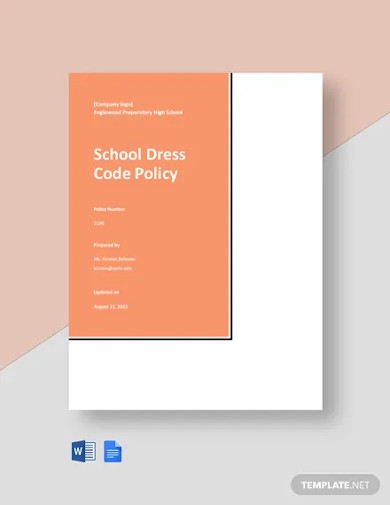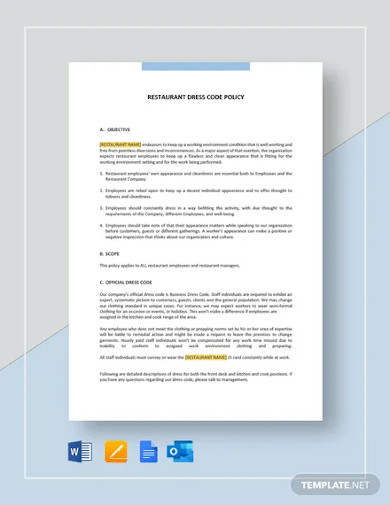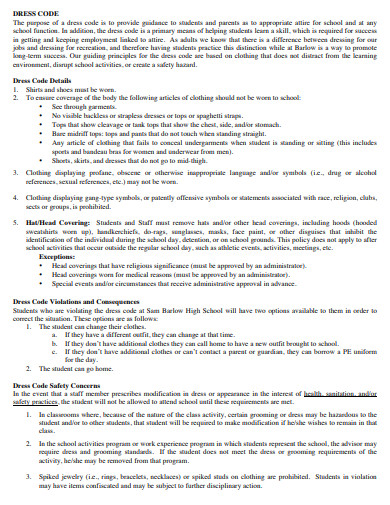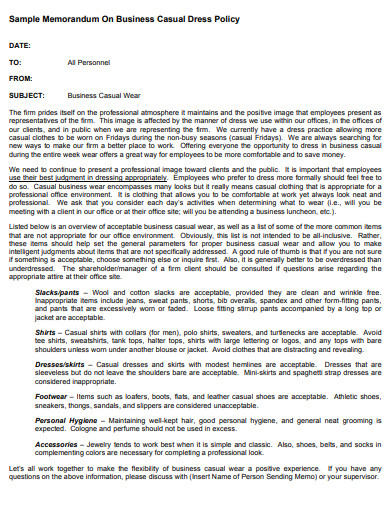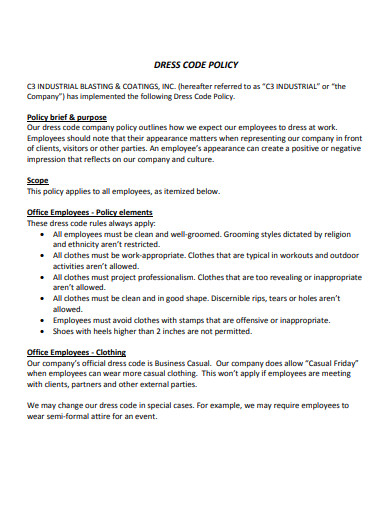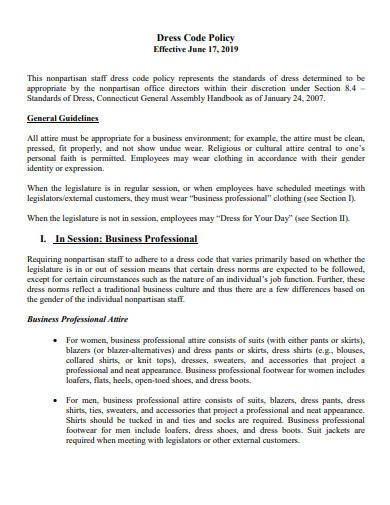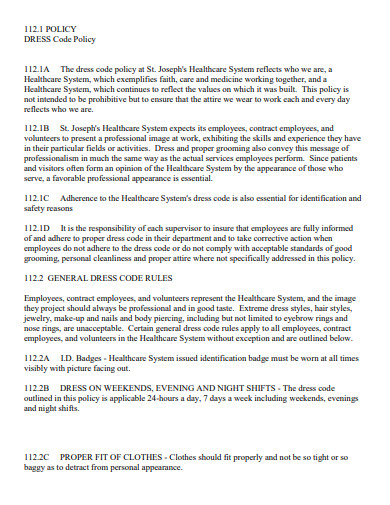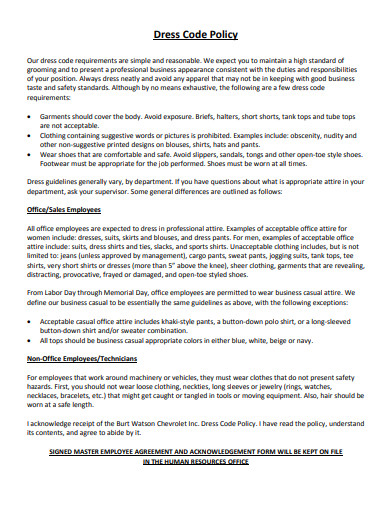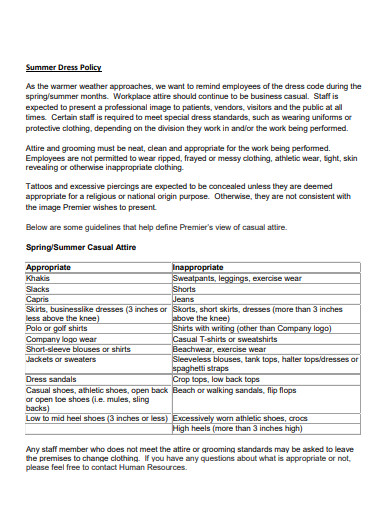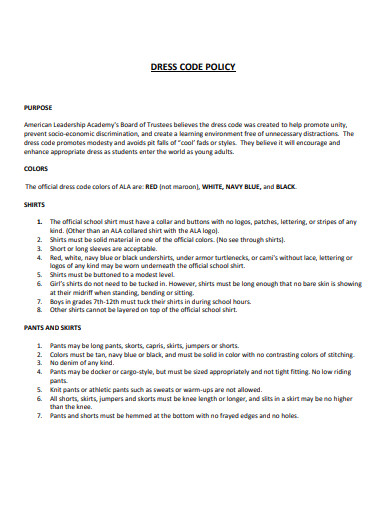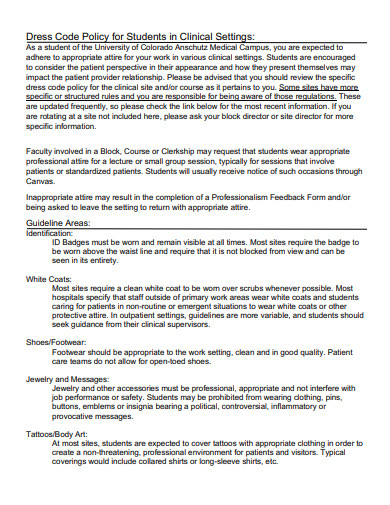10+ Dress Code Policy Examples to Download
Whether it’s at a school campus, workplace premises, or any place where a formal organization is situated, dress codes are very important. So if you’re a school administrator or a company executive, it’s your responsibility to implement a dress code in your institution or organization. If you’re tentative about how to get started, don’t be. We proudly offer you our downloadable Dress Code Policy Examples. So check them out!
10+ Dress Code Policy Examples
1. School Dress Code Policy Template
2. Restaurant Dress Code Policy Template
3. Dress Code Policy Template
4. Business Casual Dress Code Policy
5. Industrial Dress Code Policy
6. Dress Code Policy Example
7. Sample Dress Code Policy
8. Dress Code Policy in PDF
9. Summer Dress Policy
10. Basic Dress Code Policy
11. Dress Code Policy for Students
What Is a Dress Code Policy?
A dress code policy is a type of organizational policy that strictly implements what kind of attire the students or employees should wear inside the premises. In other words, it requires members of an organization or institution to dress appropriately. Dress code is one of the most vital school policies or company policies. In any school that you might attend or company that you might get employment, their higher-ups have already implemented a dress code policy in them. And you have to follow it deliberately.
What Purpose Does a Dress Code Policy Serve?
A dress code’s purpose is to ensure that people in formal premises will look decent and professional with their attire. As a school admin or company HR manager, you should implement a professional dress code if you haven’t yet. It’s part of your duty to ensure that your students or employees are wearing proper, presentable attire.
In schools, dress codes are a tool to train students on how to look professional. They’re also a way of teaching them discipline and protecting them from possible harassment, especially female students. But for private schools, dress codes are pretty straightforward. They require students to wear the prescribed school uniforms, and that’s about it.
In offices or workplaces, dress codes prompt employees to look professional, as we’ve said. However, their core function is to look presentable and trustworthy when interacting with the company’s clients or customers. Dress code is also a strict rule for company representatives when they go to meetings or do contract signing with other companies.
How to Create a Dress Code Policy
You should be knowledgeable about implementing dress code definitions on your premises. So, aside from offering our company dress code policy examples and school dress code policy examples, we’ll share with you our tips in creating one.
-
Emphasize Who Are Your Audience
Even though it’s already apparent who should follow the dress code, it’s still mandatory to emphasize them in writing the policy. That way, you can clarify to your students or employees that they’re the ones who must abide by it. It’s also one way to avoid them from making excuses for not being aware of the implemented dress code. Simply put, you have to address the dress code policy to them.
-
Write a Brief Overview
Before you talk about the dress code, write a short overview or executive summary of it first. In it, you can discuss how the dress code will benefit the institution or organization and its members. The overview functions as the introductory section of the policy, and it should set the expectations of the students or employees.
-
Explain the Dress Code Thoroughly, Including the Sanctions
When you start enumerating the dos and don’ts of the dress code, make sure to explain each of them in detail. You have to cover everything from hats, shirts, jackets, polos, pants, skirts, shoes, socks, makeup, and accessories. There should be a guideline about anything that the students and employees can or might wear.
Aside from the dos and don’ts, don’t forget to discuss the possible sanctions if they violate the dress code. These sanctions could be the issuance of a warning letter or memo at first offense. At the second offense, you can implement an immediate suspension. However, it’s up to you what punishments to impose.
-
List Down Some Exceptions
A study conducted by Stormline found that 61% of employees feel happier and more productive if they’re allowed to wear their preferred attire. The reason why that is that they feel more confident dressing however they want. They’re able to be themselves and to express their sense of fashion freely.
So if you’re worried that your dress code policy might affect your employees’ morale, you can include some exceptions. A good example would be to have a Laundry Day each week—a day when employees can wear casual clothes. However, if your company doesn’t interact with customers regularly, you should consider loosening up your dress code policy. Don’t make it too strict with a long list of regulations.
But if you’re a school admin, tightening up your dress code policy should be a must. It contributes to teaching students proper grooming and discipline.
FAQs
What are the types of dress codes in the workplace?
These are the four dress code types in offices or company premises:
- Business formal attire
- Business professional attire
- Business casual attire
- Casual office attire
What are prime examples of inappropriate office attire?
Here are some clothes and footwear that aren’t acceptable in an office setting:
- Tank tops
- Tube tops
- Halter tops
- Spaghetti-strap tops
- Midriff or crop tops
- Form-fitting pants
- Skorts
- Shorts
- Denim jeans
- Sweat pants
- Sports shoes
- Skater shoes
- Flipflops
- Sandals
How do dress codes differ from uniforms?
Dress codes are often confused as the standard uniform of a school or company. Well, they’re related, but they’re not one and the same. The definition of a dress code is that it’s a set of rules or instructions regarding proper attire. Meanwhile, uniforms are the standard attire that students or employees must wear and no other; no ifs and buts. Typically, uniforms are clothing that represents the identity or brand of an institution or organization.
Once you’re done formulating your dress code policy, integrate it into the student or employee handbook. That way, your students or employees will have a constant reminder of it. After that, your dress code policy becomes an official rule in your institution or organization. It’s not really that hard to implement a dress code policy, especially with our student and employee dress code policy examples!



